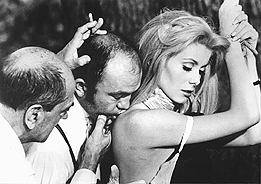|
Belle de Jour
Director Luis Bunuel has been going in and out of style for nearly 70
years, and he seems to be out of style presently. This critical and
popular neglect might have actually pleased him. He once wrote that
"commemorative ceremonies are not only false but dangerous, as are all
statues of famous men."
There hasn't been an important retrospective of his work in the last
decade, and he isn't well-represented at video outlets except for a few
of his later French pictures. Most moviegoers, if they know of Bunuel
at all, know him either as Salvador Dali's surrealist collaborator on
Un Chien Andalou and L'Age d'Or or as the
urbane master of such 1970s comedies as The Discreet Charm of the
Bourgeoisie and That Obscure Object of Desire .
His trend-setting comedy of sexual repression, Belle de
Jour (1967), unseen except in bootleg prints for years, has
at last been re-released in a new print, thanks to the restoration
efforts of Martin Scorsese.
Bunuel was Spain's greatest filmmaker, even if he made almost all of
his best-known films across Spain's border, in exile from the fascists.
He also spent a long period in Mexico busy putting together everything
from melodramas to Latin reinterpretations of The Adventures of
Robinson Crusoe (1952) and Wuthering
Heights (1953).
During this time, Bunuel also made his world-famous Los
Olvidados (1950, The Forgotten Ones ) about the
slums of Mexico City. All these films would certainly make for enticing
viewing if you could just get to see them. Bunuel stayed in Mexico long
enough to become a citizen, but a man like Bunuel would be an exile
anywhere, and he later summed up some of his 15-year-long stay there as
"scratching his nose, watching flies and living off my mother's
money."
If I were teaching film, Bunuel's memoirs, My Last Sigh
(Jonathan Cape, 1984), would be required reading, as instruction on how
an artist both comes to terms with, and overcomes, a background of
repression. Bunuel was born in the town of Calanda, in Aragon, where,
he wrote later "the Middle Ages lasted until World War I."
Church bells told the time, the date and whether someone in the village
was dying. Calanda is the place where the Virgin of Pilar, Spain's
patron, regrew a leg on an amputee in 1604, an occurrence that was
still discussed in Bunuel's youth. (The severed limb turns up in his
1970 film, Tristana. )
Aragon exhibited the medieval differences between poverty and wealth,
along with the usual other contrasts--between man and woman, chastity
and lasciviousness--all of which Bunuel explored in his films. There
for him was first visible "the interminable war between instinct and
virtue," as he put it. And he's never taken sides in this war.
A cafe lounger and art student, his decision to become a film director
had a whimsical quality; he later wrote that it was as if he told his
mother he wanted to join the circus and become a clown.
Borrowing the money from his mother, Bunuel made (with Dali) the short
film Un Chien Andalou (1928), the best-known and most
watchable of surrealist films. From its still-shocking opening image of
an eyeball being slit with a straight razor to the random series of
events, "no idea or image that might lend itself to the rational
explanation of any kind would be accepted," as Bunuel described it.
Un Chien Andalou perfectly demonstrates how film
communicates by sheer force of mood and imagery, from slapstick
vulgarity to sharp menace. The film communicated well enough to get
Bunuel a round-trip to Hollywood, thanks to MGM. "I didn't like it,
and I didn't understand the first thing about it ... but somehow I
can't get it out of my mind," said the representative who signed him
up--the perfect Bunuel review.
If the imagery in a Bunuel film is sometimes opaque, the intention is
always clear. Bunuel saw surrealism as a revolutionary movement. Now
that surrealism is a dead institution, this notion may be hard to
understand.
There's a striking early photograph in Bunuel's memoirs of Dali. Think
of Dali's overpriced serigraphs at tourist-trap galleries and then be
surprised by seeing him as he was in his youth: formidable,
Mohawk-wearing and looking very much like Travis Bickle, Scorsese's
antihero from The Taxi Driver .
Surrealism was "a moral movement," Bunuel wrote. Shock was its weapon
against "the exploitation of one man by another, colonialist
imperialism, religious tyranny--in sum, all of the secret and odious
underpinnings of a society that had to be destroyed."
During the Spanish Civil War, Bunuel recalled, a truck load of workers
drove 20 kilometers to stage a firing squad on a colossal statue of
Jesus. It was a scene, for all its blasphemy and solemn silliness, that
could have been in one of his movies.
Bunuel loathed the corruption of the Catholic Church. Still, like a lot
of the ex-Catholic faithless, Bunuel wondered over the good that might
be entombed under the tons of religious debris. This vein of skepticism
runs throughout his life and art.
With luck, Bunuel's work will be as resilient as his enemies: the
excesses of organized religion, the evergreen appeal of fascism. Maybe
it is low reading levels among today's malcontents, allergic to
subtitles, that explains why many young filmmakers haven't discovered
this major force in against-the-grain cinema. Perhaps the best thing
about Bunuel's movies is that his rebelliousness equaled his
pragmatism. This is why his work is in need of reprise: modern movies
are starved for both qualities.
[ Movies Central | MetroActive ]
| ||||||||||||||||||||||||||||||
Copyright 1994-2025 Weeklys. This page is part of Metro Silicon Valley's historical archive and is no longer updated. It may contain outdated information or links. For currently information, please go to MetroSiliconValley.com home page, e-edition or events calendar.
This page was designed and created by the Boulevards team.

